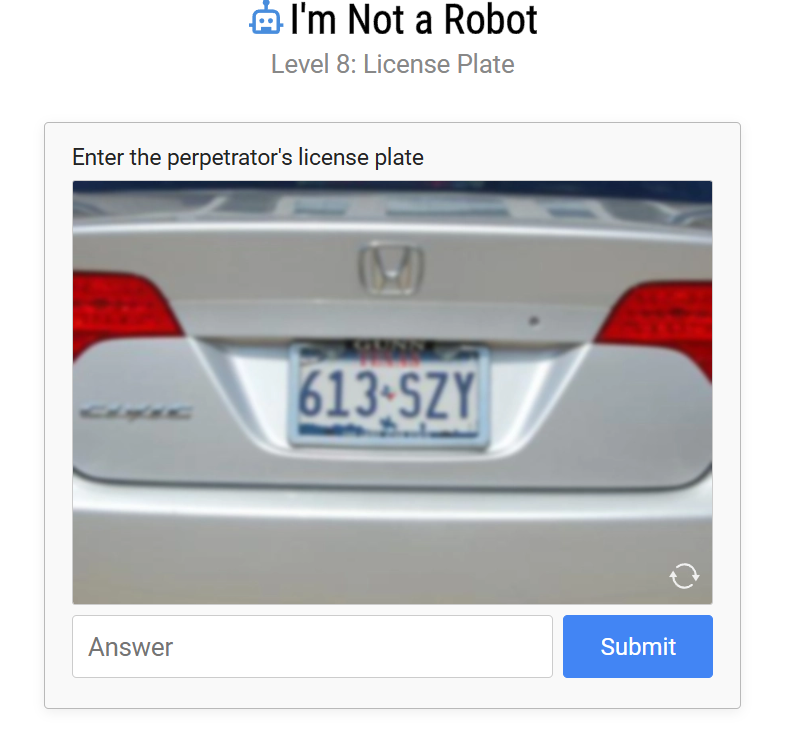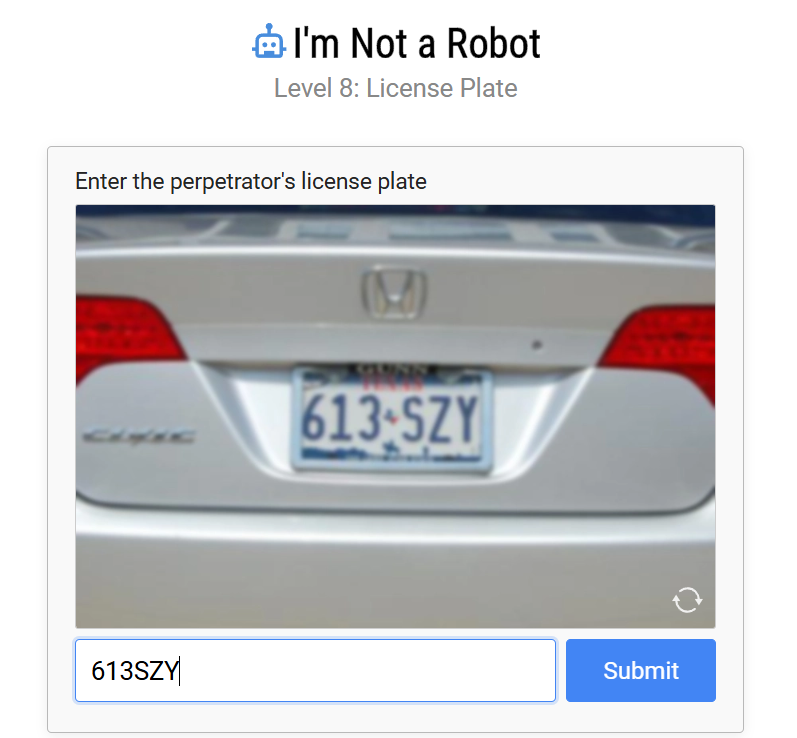How to Beat Level 8 in I'm Not a Robot - License Plate Guide
TL;DR
- Objective: Master Level 8 of Neal.Fun's 'I'm Not a Robot' by accurately transcribing a license plate number.
- Steps: Carefully read each character, distinguish similar letters/numbers, maintain exact spacing and capitalization.
- Verification: Type the license plate exactly as shown, including all formatting elements.
- Risk: Even minor character mistakes, spacing errors, or capitalization issues will cause failure.
This guide provides a comprehensive approach to conquering Level 8 of Neal.Fun's 'I'm Not a Robot' game, specifically the challenging license plate recognition task. Players frequently struggle with character disambiguation and formatting precision, making this level particularly frustrating. This article breaks down the solution into systematic steps, ensuring accurate transcription and successful progression.
Unlocking Level 8: The License Plate Recognition Challenge Explained
Level 8 of Neal.Fun's 'I'm Not a Robot' game introduces a sophisticated optical character recognition (OCR) challenge that mimics real-world license plate reading scenarios. Unlike previous levels that rely on visual selection, this puzzle demands precise text input, testing your ability to accurately distinguish between similar-looking characters and maintain exact formatting standards. The challenge lies not just in reading the characters, but in reproducing them with perfect fidelity to spacing, capitalization, and character accuracy.

Level 8 License Plate Challenge
Mastering License Plate Recognition: A Step-by-Step Character Analysis Guide
The key to successfully navigating Level 8 of 'I'm Not a Robot' lies in systematic character recognition and meticulous attention to formatting details. The puzzle presents a vehicle's license plate that must be transcribed exactly as displayed. Follow these precise steps to complete the character recognition process:
Step 1: Initial Image Assessment
- Objective: Evaluate the license plate's clarity and identify potential recognition challenges.
- Procedure: Examine the entire license plate for image quality, lighting conditions, and any visual obstructions. Note the total character count and overall formatting structure. If the image appears blurry or unclear, consider using the refresh option to obtain a clearer version before proceeding with transcription.
Step 2: Character-by-Character Analysis
- Objective: Systematically identify each character from left to right with maximum accuracy.
- Procedure: Begin reading from the leftmost character and progress sequentially. Pay special attention to character disambiguation:
- Zero (0) vs. Letter O: Zeros typically appear more oval and narrow, while letter O's are more circular
- One (1) vs. Letter I vs. Lowercase L: Number 1 often has serifs or distinctive base, letter I may have horizontal bars, lowercase l is typically thinner
- Five (5) vs. Letter S: Number 5 has angular construction, letter S has curved elements
- Six (6) vs. Letter G: Number 6 is more closed and circular, letter G has an opening and horizontal bar
- Eight (8) vs. Letter B: Number 8 has symmetrical loops, letter B has different-sized compartments
Step 3: Spacing and Formatting Verification
- Objective: Ensure exact replication of spacing, dashes, and capitalization as shown.
- Procedure: After identifying all characters, verify the spacing between character groups. Most license plates use specific formatting patterns such as "ABC-123" or "ABC 123". Include any dashes, spaces, or special characters exactly as they appear. Confirm that capitalization matches the original - most plates use uppercase letters, but verify each character's case individually.

Level 8 License Plate Example
Step 4: Input Validation and Submission
- Objective: Enter the transcribed license plate with perfect accuracy.
- Procedure: Type the license plate number slowly and deliberately, double-checking each character as you input it. Review the entire sequence before submission, paying particular attention to character accuracy, spacing, and capitalization. The system requires exact matching - even minor discrepancies will result in failure and require restarting the challenge.
Common Mistakes and Advanced Troubleshooting
- Character Confusion: The most frequent errors involve misidentifying similar characters. When uncertain, consider the context of typical license plate patterns and regional formatting conventions.
- Spacing Errors: Missing or incorrect spacing between character groups is a common failure point. Some plates use dashes, others use spaces, and some have no separation - match exactly what you see.
- Capitalization Inconsistency: While most license plates use uppercase letters, always verify the actual case shown in the image rather than assuming standard formatting.
- Input Method Issues: Ensure your keyboard input method matches the expected character set. Some systems may interpret certain characters differently.
Behind the Challenge: Understanding OCR Complexity in Anti-Bot Systems
Neal.Fun's Level 8 cleverly simulates the real-world challenges faced by automated systems when processing license plate data. This puzzle highlights the sophisticated pattern recognition required for accurate text extraction from images, particularly when dealing with standardized but variable formats like license plates. The challenge serves as both entertainment and education about the complexities of computer vision and character recognition technologies.
The difficulty stems from the inherent ambiguity in character shapes, especially when viewed at different angles, lighting conditions, or image qualities. Real OCR systems employ complex algorithms and machine learning models to achieve high accuracy rates, while humans rely on contextual understanding and pattern recognition. This level tests your ability to perform accurate character recognition under conditions that might challenge both human perception and automated systems.
Pro Tips for Conquering Character Recognition Challenges
Mastering Level 8 and similar text-based puzzles requires developing systematic approaches to character analysis and input validation. These strategies will improve your success rate across various recognition challenges.
Tip 1: Develop Character Discrimination Skills
- Objective: Build expertise in distinguishing between visually similar characters.
- Details: Practice identifying the subtle differences between commonly confused characters. Focus on distinctive features like character width, height ratios, presence of serifs, and internal spacing. Develop mental templates for each character type to improve recognition speed and accuracy.
Tip 2: Use Contextual Analysis
- Objective: Leverage knowledge of license plate formatting conventions to validate character choices.
- Details: Most license plates follow regional patterns for character placement and type. Letters typically appear in certain positions, while numbers occupy others. Use this knowledge to double-check ambiguous characters - if a character could be either a letter or number, consider its position in the sequence.
Tip 3: Implement Systematic Verification
- Objective: Establish a consistent process for reviewing and validating your transcription.
- Details: Always perform a final character-by-character comparison between your input and the original image. Read your transcription aloud while looking at the image to catch discrepancies. Pay special attention to the beginning and end of the sequence, where errors are most likely to occur.
Tip 4: Manage Visual Fatigue
- Objective: Maintain optimal visual acuity throughout the recognition process.
- Details: Take brief breaks if you've been staring at the image for extended periods. Visual fatigue can lead to character misidentification and reduced accuracy. If possible, adjust your screen brightness and contrast to optimize character visibility.
Frequently Asked Questions About License Plate Recognition
Players often encounter similar challenges when tackling Level 8's character recognition requirements. Here are answers to the most common questions:
-
Q1: Why does my transcription keep failing even when I'm confident it's correct?
- A1: The most common causes are subtle character misidentification (especially 0 vs O, 1 vs I), incorrect spacing, or capitalization errors. Review each character individually and ensure exact spacing matches the original image.
-
Q2: How can I tell if a character is a zero or the letter O?
- A2: Zeros are typically more oval and narrow, while letter O's tend to be more circular. In license plate fonts, zeros may also have a diagonal slash or dot to distinguish them from letters.
-
Q3: What should I do if the license plate image is unclear or blurry?
- A3: Use the refresh option to request a clearer image. Don't attempt transcription on unclear images, as this significantly increases the likelihood of character misidentification.
-
Q4: Are there different license plate formats I should be aware of?
- A4: Yes, license plates can vary by region and type. Some use "ABC-123" format, others "ABC 123", and specialty plates may have unique arrangements. Always match the exact format shown in the image.
-
Q5: How can I improve my character recognition accuracy?
- A5: Practice with similar character recognition exercises, develop systematic scanning techniques, and learn the distinctive features of commonly confused characters. Take your time and prioritize accuracy over speed.
Final Summary
Successfully completing Level 8 of 'I'm Not a Robot' requires meticulous attention to character recognition accuracy, spacing precision, and formatting fidelity. The challenge tests your ability to perform reliable optical character recognition under conditions that can confuse both humans and automated systems. Master this level by developing systematic character analysis skills, implementing thorough verification processes, and maintaining focus on exact transcription rather than approximate matching. Remember that even minor errors will result in failure, making precision the ultimate key to success.